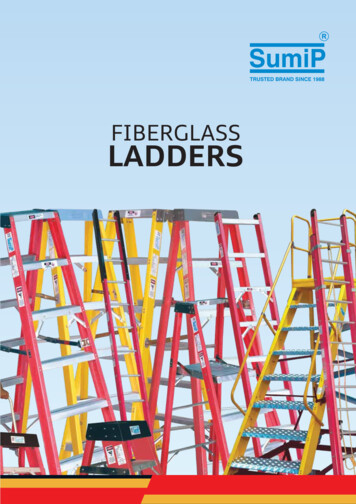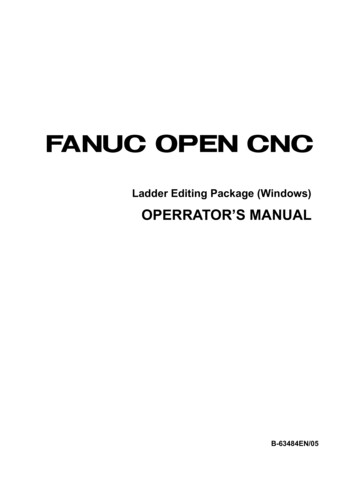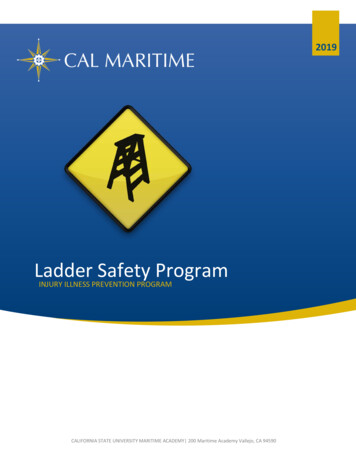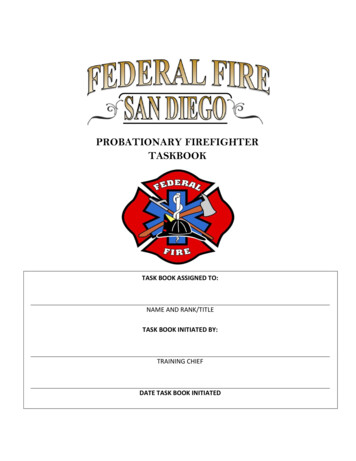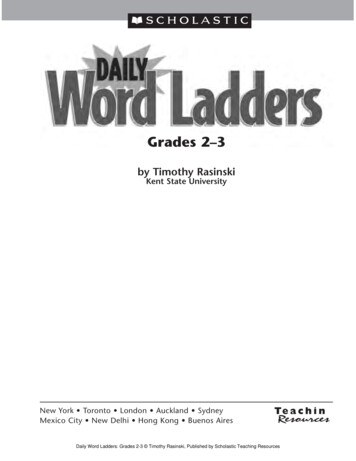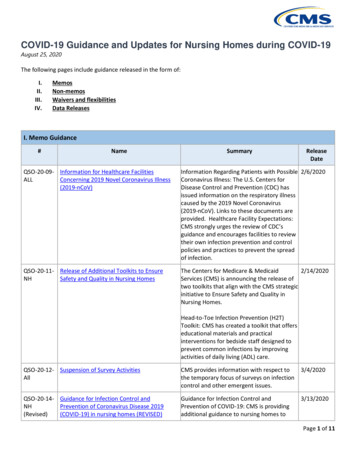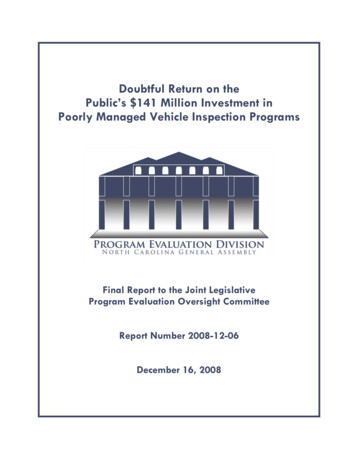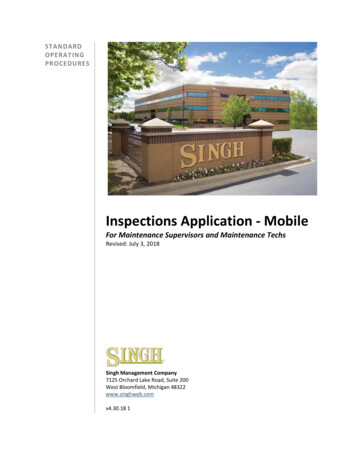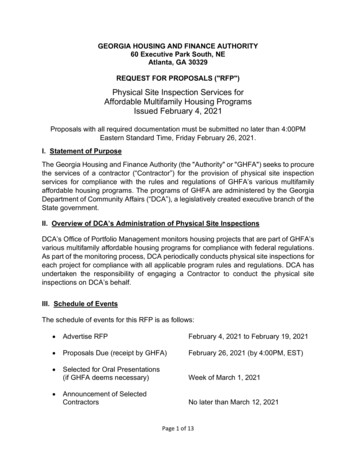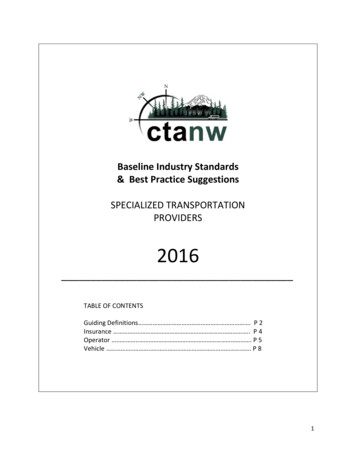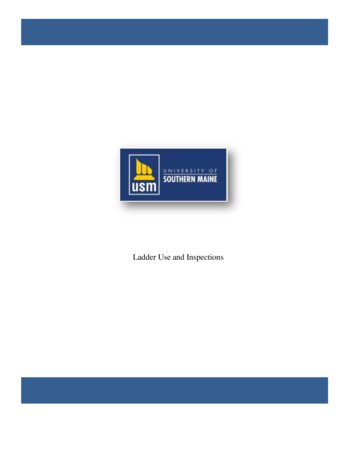
Transcription
Ladder Use and Inspections
THE UNIVERSITY OF SOUTHERN MAINEENVIRONMENTAL HEALTH AND SAFETYLadder Use and InspectionsGeneral“Portable Ladder Use and Inspection” guidelines have been developed toestablish recommendations for the safe use of portable ladders by University ofSouthern Maine personnel. Occupational Safety and Health Administration(OSHA) standards require that all ladders be used appropriately, that a periodicinspection be established for all ladders, and that personnel using ladders betrained in the proper use, limitations, and maintenance of ladders used.The term portable ladder includes all step ladders, extension ladders, step stools,specialty type ladders (e.g.; trestle ladders; trolley and side rolling ladders) andother portable devices intended or constructed expressly for the purposes ofproviding access to spaces or materials.RegulatoryGuidanceMaine Occupational Safety and Health Standards for General Employment in thePublic SectorMaine Occupational Safety and Health Standards for Construction Employmentin the Public SectorOccupational Safety and Health Administration (OSHA) 29 CFR:1910.25 – Portable Wood Ladders (General Industry)1910.26 – Portable Metal Ladders (General Industry)1926.1053 – Ladders (for Construction)1926.1060 – Training Requirements (for Construction)RequirementsGeneralLadders must be inspected by a competent person for visible defects on aperiodic basis and after any occurrence that could affect safe use.All employees using ladders must conduct a pre-use inspection (see below).Ladders must be appropriate for task and properly maintained where required toprovide access to places where employees perform the task.Use ladders equipped with nonconductive side rails (e.g., fiberglass ladders) if theworker or the ladder could contact exposed energized electrical equipment.Never use a metal ladder near any electrical conductor or electrified equipment.
Ladder Use and Inspections, Page 2The following apply to all ladders as applicable: Rungs/steps must be free of grease, oil, or any other substance thatwould make them slippery. Ladders are not be painted with an opaque finish or coated with anymaterial that might hide defects. Ladders/step stools must not carry loads beyond written rating Only one person at a time may use or work from a single ladder.Use ladders only for their designed purpose.Keep areas clear around the top and bottom of ladders.Face the ladder when climbing up or down.Carry items up and down ladders using a pouch, holster, or tool belt.Small, non-bulky items, may be hand carried as long as the items donot impede the ability to maintain full control while climbing ordescending the ladder. Ladder users should completely focus theirattention on climbing up and/or down a ladder for a safe ascent ordescent. Large or heavy items should be pulled up or lowered with ahand line or rope specifically for that purpose. Ladder users should maintain at least three points of contact withthe ladder. For example, two feet and one hand, or two hands andone foot should be in contact with the ladder at all times. Never stand on the top two steps of any ladder.Keep your body centered within the frame of the ladder. Do notover-extend your body past the side rails.Ladder PlacementPlace ladders on a level and firm footing. Ensure ladder is rigid, stable, and secure to preventaccidental movement.Avoid supporting ladder side rails with boxes, loose bricks, or other loose packing to createstability or to attempt to gain extra height.Avoid placing ladders in front of a door opening unless the door is fastened open, locked, orguarded. Use an effective method (e.g., warning cones, warning signs, barricades) to detourpedestrian traffic away from the ladder to prevent dislodgment or someone walking into orunderneath the ladder.Setting ladders requires proper care and angle. A simple rule for setting a ladder is to place thebase out at a distance of ¼ the length of the ladder (this is commonly referred to as the 4 to 1ratio). This means that the bottom of the ladder should be 1 ft away from the wall for every 4 feetthat the ladder rises.For example, if the ladder touches the wall at 12 ft above the ground; angle the ladder so that thebase is 3 ft from the wall.Ladders must extend at least 3 ft above any landing place or roof unless grab railings are provided.Ladder Use and Inspections, Page 3
Climb down to position or reposition the ladder. Avoid moving, shifting, extending or walking aladder while you or someone else is standing on it.Securing the LadderLadders should be securely fixed at the top and bottom so that they cannot move. If it is notpossible to secure a ladder at both the top and bottom then it should be securely fixed at the base.If this is not possible, then a person may stand at the base of the ladder and secure it manuallyagainst slipping.Step ladders must be completely spread open and locked before use.Do not use ladders on slippery surfaces unless secured or provided with slip- resistant feet toprevent accidental movement. Non-slip feet are not a substitute for exercising care when placing,lashing or holding a ladder on slippery surfaces.Pre-Use Visual InspectionsAll ladder users must conduct a visual inspection prior to use of the ladder. The inspection shallinclude: Locating label on ladder for commercial use and a certified duty loadrating Ensuring side rails, braces, steps, rungs are free from splinters, cracks,dents, & bends Verifying extension ladder ropes are not frayed, pulleys work smoothlyand rung locks operate correctly Ensuring ladder is not painted or covered with anything that could hidedefects Checking for decay, damage, loose nails, screws, bolts, pin, faulty welds,cracks or sheared rivets. Checking the joints between the rungs and the side rails for tightness.Joints are loose if the rungs can be moved by hand. Verifying rungs or steps are in place.Ensuring metal ladder rungs/steps are corrugated or knurled to preventslipping Ensuring ladder rungs/steps are free of grease, oil, or any othersubstance that would make them slippery. Verifying stepladders have a metal spreader or locking device to securelyhold the front and back sections in an open position. Ensure spreaderdoes not have any sharp objects protruding from it. Ensuring all moveable parts operate freely without binding.Checking to ensure that the feet are in good condition and not broken.Ladders with structural defects or needing repairs must immediately be marked defective ortagged with "Do Not Use" or similar language and withdrawn from service until repaired.Ladder Use and Inspections, Page 4
Repairs must be carried out by a competent person to UL and/or manufacturerstandards. Where repair is not completed the ladder must be destroyed.StorageAll ladders, when not in use, shall be secured and not cause a hazard.TrainingTraining must be provided by each department to ensure that those University ofSouthern Maine personnel or students using ladders understand the purpose,function, and limitations of ladders to be used. In addition, ladder users who arepainting, decorating, renovating, or constructing should be trained by a competentperson, as appropriate:1. The nature of fall hazards in the work area;2. The correct procedures for erecting, maintaining, and disassembling thefall protection systems to be used, if any;3. The proper construction, use, placement, and care in handling of allstairways and ladders;4. The maximum intended load-carrying capacities of ladders; and5. The regulatory standards that apply (e.g., 29 CFR 1926.1053).Users should be familiar with information in this document.Retraining must be provided for each employee as necessary.ResponsibilitiesSafety and Environmental Management Assist departments in ladder selection, upon request.Assist departments in developing ladder training.Department Chairs or Directors Provide the appropriate ladders where necessary. Ensure that periodic inspections of all ladders areperformed.Supervisors Provide the appropriate ladders for employee or student use.
Ladder Use and Inspections, Page 5 Provide training for ladder users and document training whenrequired (documentation is required for construction workers).Training is generally provided as part of the Department AnnualSafety Training or as part of the course curriculum. Ensure that ladders are inspected prior to each use and that unsafeladders are removed from service and labeled “DO NOT USE!” Ensure that ladders that are removed from service and are not goingto be repaired are destroyed.Individual Complete ladder safety training, as required. Follow all required ladder inspection, use, and labeling requirements. Do not use unsafe ladders and immediately report any unsafe andunlabeled ladders to your supervisor for removal from service.DefinitionsCompetent Person: An individual, who by way of training and/or experience isknowledgeable of applicable standards, is capable of identifying workplacehazards relating to the specific operation, is designated by the employer, and hasauthority to take appropriate actions.Extension ladder: A non-self-supporting portable ladder adjustable in length.It consists of two or more sections traveling in guides or brackets so arranged asto permit length adjustment. Its size is designated by the sum of the lengths ofthe sections measured along the side rails.Maximum intended load: The total load of all employees, equipment, tools,materials, transmitted loads, and other loads anticipated to be applied to a laddercomponent at any one time.Portable ladder: A ladder that can be readily moved or carried.Side-rolling ladder: A semi-fixed ladder, nonadjustable in length, supported byattachments to a guide rail, which is generally fastened to shelving, the plane ofthe ladder being also its plane of motion.Step ladder: A step ladder is a self-supporting portable ladder, nonadjustable inlength, having flat steps and a hinged back. Its size is designated by the overalllength of the ladder measured along the front edge of the side rails.Step stool (ladder type): A self-supporting, foldable, portable ladder,nonadjustable in length, 32 inches or less in overall size, with flat steps andwithout a pail shelf, designed to be climbed on the ladder top cap as well as allsteps. The side rails may continue above the top cap.Trolley ladder: A semi-fixed ladder, nonadjustable in length, supported byattachments to an overhead track, the plane of the ladder being at right angles tothe plane of motion.
Ladder Use and Inspections, Page 6For Additional InformationContact your Department Safety Coordinator or University Environmental Health and Safety Department.Document HistoryLadder Use and Inspections,Date of last revision6-12-16
Occupational Safety and Health Administration (OSHA) 29 CFR: 1910.25 - Portable Wood Ladders (General Industry) 1910.26 - Portable Metal Ladders (General Industry) 1926.1053 - Ladders (for Construction) 1926.1060 - Training Requirements (for Construction) All employees using ladders must conduct a pre General
